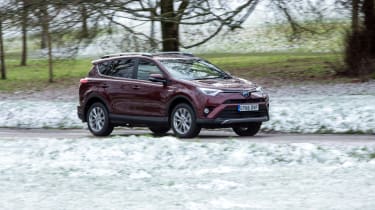Toyota RAV4 (2013-2018) review - MPG, CO2 and Running Costs
Low CO2 emissions mean the RAV4 is a solid company car choice, but economy is average

The most economical Toyota RAV4 is the 2.0-litre D-4D diesel mode, which returns 60.1mpg and emits 123g/km of CO2. That's true whichever model you go for, with larger wheels making no difference to the economy (though they do raise CO2 emissions by 1g/km).
Go for the hybrid and you'll find lower CO2 emissions and therefore lower VED and company car tax costs - but not by much, as the FWD model emits 115g/km and the AWD model emits 118g/km. Economy figures are just behind the diesel too, with the front-wheel drive model returning 57.6mpg and the all-wheel drive car returning 55.4mpg.
The most expensive model to run will be the 2.0-litre petrol, which emits 152g/km and returns 43.5mpg. We'd steer clear of this model in most cases - it's not even cheaper to buy than the more efficient diesel.
The Mazda CX-5's 2.2-litre diesel returns 61mpg, which just about beats the RAV4, but the lower-powered Renault Kadjar diesel returns 74.3mpg. Even the higher-powered Renault returns 65.7mpg - so there are better choices in the crossover class if fuel economy is important to you.
Insurance groups
While rivals like the Nissan Qashqai and Mazda CX-5 are placed into insurance groups 15-20, the RAV4 will be more expensive to insure - the 2.0 diesel model is in insurance group 28 and the hybrid in group 32. Going for the four-wheel drive version will increase premiums too, with the hybrid model going up to group 34 in AWD form.
Depreciation
The Toyota RAV4 will hold on to about 43 per cent of its value after three years, which is about the same as many of its rivals. The Skoda Yeti manages 43 per cent, for example, and the Nissan Qashqai 45 per cent. Entry-level models are more likely to hold on to their value, with top-spec cars losing out the most.








